Traffic lights, also referred to as stop lights or traffic signals, are crucial devices for controlling pedestrian and vehicular traffic. Road crossings and junctions are kept safe and organized by these lights, which indicate whether to stop, proceed, or move. Although most people are familiar with the classic red, yellow, and green traffic signals, there are many more types of traffic lights that are tailored to specific uses depending on traffic patterns, road types, and user needs. To comprehend how contemporary traffic systems function effectively and securely, you must be aware of the many types of traffic lights. We will explain from traffic lights types to use scenarios in this article. Just stay tuned with us!
What Are Traffic Lights or Traffic Lights Meaning
We will learn the basic questions regarding traffic lights in this section, like, How do traffic lights work? Who made the Traffic light, or who invented the traffic light? How much do traffic lights weigh? How tall are traffic lights? Let’s know all the interconnected answers. Traffic lights use timed or sensor-triggered systems to control traffic flow through red, yellow, and green lights. They are often controlled by computerized controllers that adapt to traffic conditions. Garrett Morgan invented the first electric traffic light in 1923, albeit J.P. Knight had already developed a non-electric version in London in 1868. A typical traffic light can weigh between 30 and 50 pounds (13 and 23 kg), depending on its size and design, and the poles it is mounted on can range in height from 8 to 20 feet (2.5 to 6 meters).
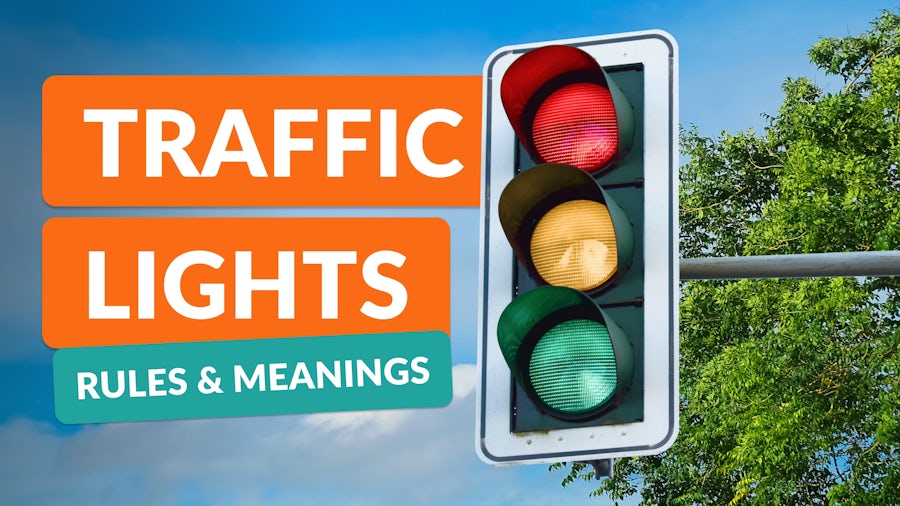
The Role & Function of Types of Traffic Lights
Traffic lights are found on the majority of regular cars. Traffic lights come in a wide variety, each with a unique set of features. Only three colors are used by most individuals to interpret traffic signals. The following are the functions of traffic signaling devices:
-
Regulating Traffic Flow
Indicating signals are essential for encouraging the efficient and safe movement of cars and pedestrians along roadways. Without them, crossing roads would be risky and chaotic, particularly in places with heavy traffic.
Traffic signals cycle between green, yellow, and red to let cars and pedestrians know when to go and when to stop. This collaboration ensures that no one path is given favor or unduly impedes others, which keeps the workflow efficient and minimizes misunderstandings.
-
Reducing Traffic Congestion
A traffic jam occurs when too many cars attempt to utilize the same road at once, particularly during rush hour. Traffic signals, which track the length of each activity, help to solve this issue. Smart traffic management systems modify the timing of traffic lights based on the volume of traffic in the region using real-time data or sensors.
For instance, the green light may remain on longer on a route with higher traffic, enabling more vehicles to pass. Traffic signals make it obvious when it is safe to move forward, which lowers the chance of an accident.
-
Enhancing Road Safety
The main goal of traffic signals is to keep everyone on the road safe, including cyclists, pedestrians, and drivers. This adaptable management avoids unnecessary delays and guarantees a fair workload distribution during changes. For example, if all vehicles stop at a red light, it permits safe travel in other directions.
Additionally, they lessen risky behaviors like racing through intersections or attempting to determine who has the right-of-way. Traffic lights reduce the chance of cars colliding with pedestrians in places where there are a lot of tall individuals strolling about.
-
Managing Pedestrian Movement
The pedestrian operations coordinator keeps an eye on walking-related events. This contains pedestrian guidance signals such as walk/do not walk signs. At congested crossroads, traffic lights and pedestrian signals cooperate to halt vehicles and protect people crossing the street.
To help the elderly and disabled, some crosswalks additionally have start clocks or auditory signals. In cities, these measures improve pedestrian access and safety.
-
Assigning Right of Way
Uncertainty about who should initiate the travel can lead to misunderstandings. Activity signals that transfer control between different directions govern the right-of-way. Eye contact and hand gestures, which can be dangerous and confusing, are no longer necessary for drivers.
For instance, when traffic is heading north and south and there is a green light, cars going east and west have to halt. This carefully thought-out development has led to the equitable and orderly use of shared roads.
-
Preventing Accidents at Intersections
The majority of accidents occur at intersections, particularly side-impacts and crashes in designated zones. By clearly separating opposing activity trends, traffic signals reduce these risks. Oncoming cars should stop even if a green arrow indicates that it is safe to turn left.
Red signals require drivers to stop completely in order to avoid crashes with other cars, whereas yellow signals warn drivers to get ready to stop. At junctions, red light cameras and traffic light sensors help avoid infractions and lessen collisions.
-
Supporting Emergency Vehicle Access
To save lives, emergency vehicles, including police cars, fire engines, and ambulances, need to be able to move swiftly through traffic. Many contemporary towns use technologies that can recognize emergency vehicles and alter traffic signals to provide them with a clear way.
It may be required to turn all the lights to red while navigating the situation. In an emergency, it reduces the risks to other road users and speeds up the completion of emergency responders’ tasks.
What are the Different Types of Traffic Lights?
In this section, you will learn about different traffic light types in detail.
-
Motor Vehicle Traffic Signals
The most common type of traffic light is the Engine Vehicle traffic Signal, which is mostly used to regulate traffic at crossroads, crossings, and junctions. These signals all use the same color system, with green denoting proceed, yellow denoting warning, and red denoting stop. By giving drivers instructions on when to start and stop their vehicles, they guarantee that they are built to work well and lower the risk of accidents. For best visibility, these signs are usually hung high or positioned at eye level.

-
Pedestrian Traffic Lights
The purpose of pedestrian signals is to help individuals cross the street safely. These are commonly located at pedestrian crossings or busy junctions. Pedestrian signals typically display a green or white Walk sign when it is safe to cross and a red hand symbol indicating Do not Walk when it is not. To make walking safer for those with vision impairments, contemporary crosswalks may have sound alerts and countdown clocks.
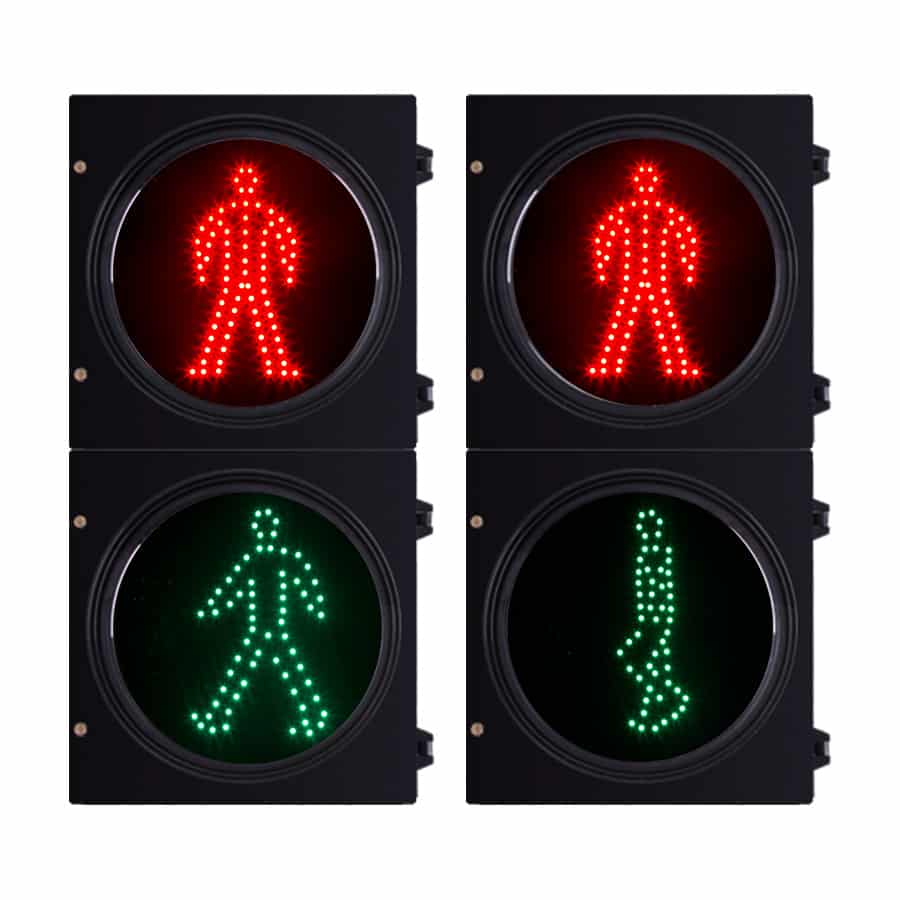
-
Arrow Traffic Lights
At junctions, turning movements are controlled by arrow traffic signs, which are red, yellow, and green arrows pointing in particular directions, such as left or right. You can turn safely when the signal is green since approaching traffic will not obstruct you; however, when it is yellow, it means the turn is almost over. A red bolt prevents you from turning in that direction. Because there is less uncertainty about who has the right-of-way when turning, these lights make crossing safer.
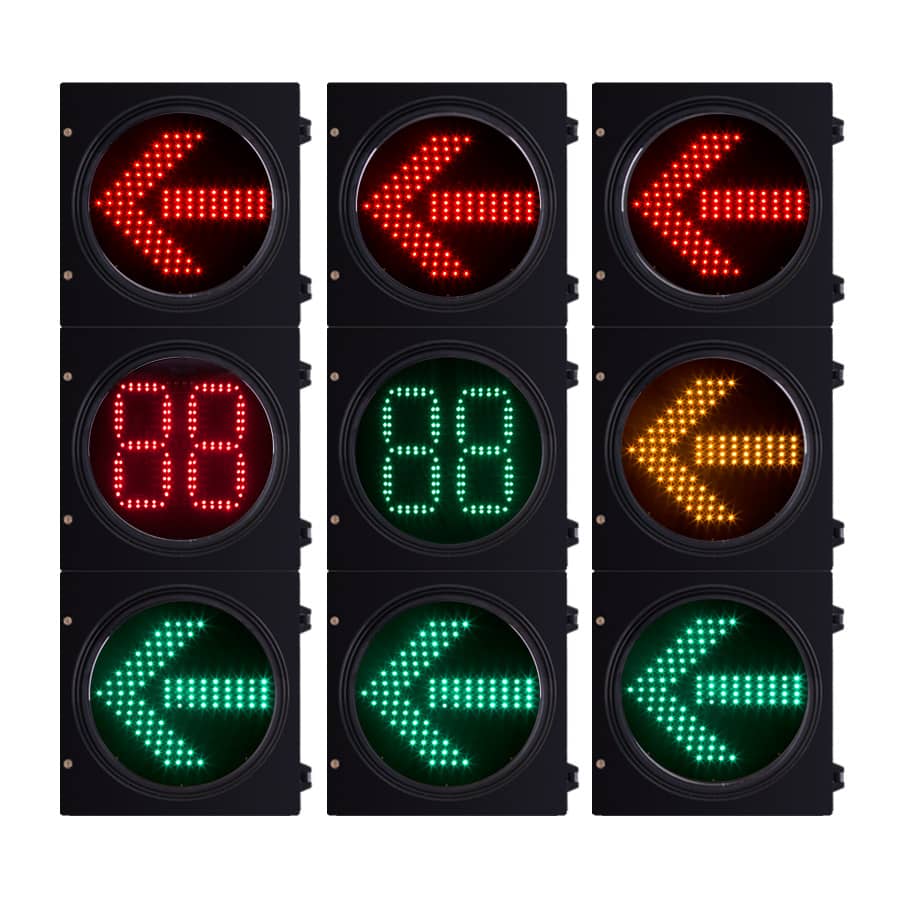
-
Flashing Traffic Signals
Flashing lights or blinking lights are commonly employed on roads with few cars or at junctions when traffic is light. As a stop sign, the blinking red traffic light instructs drivers to stop completely and only allows them to continue when it is safe to do so. A bright yellow traffic light sign warns cars to drive carefully and to stop if needed. These signals alert drivers to exceptional road conditions in emergencies or in development zones.
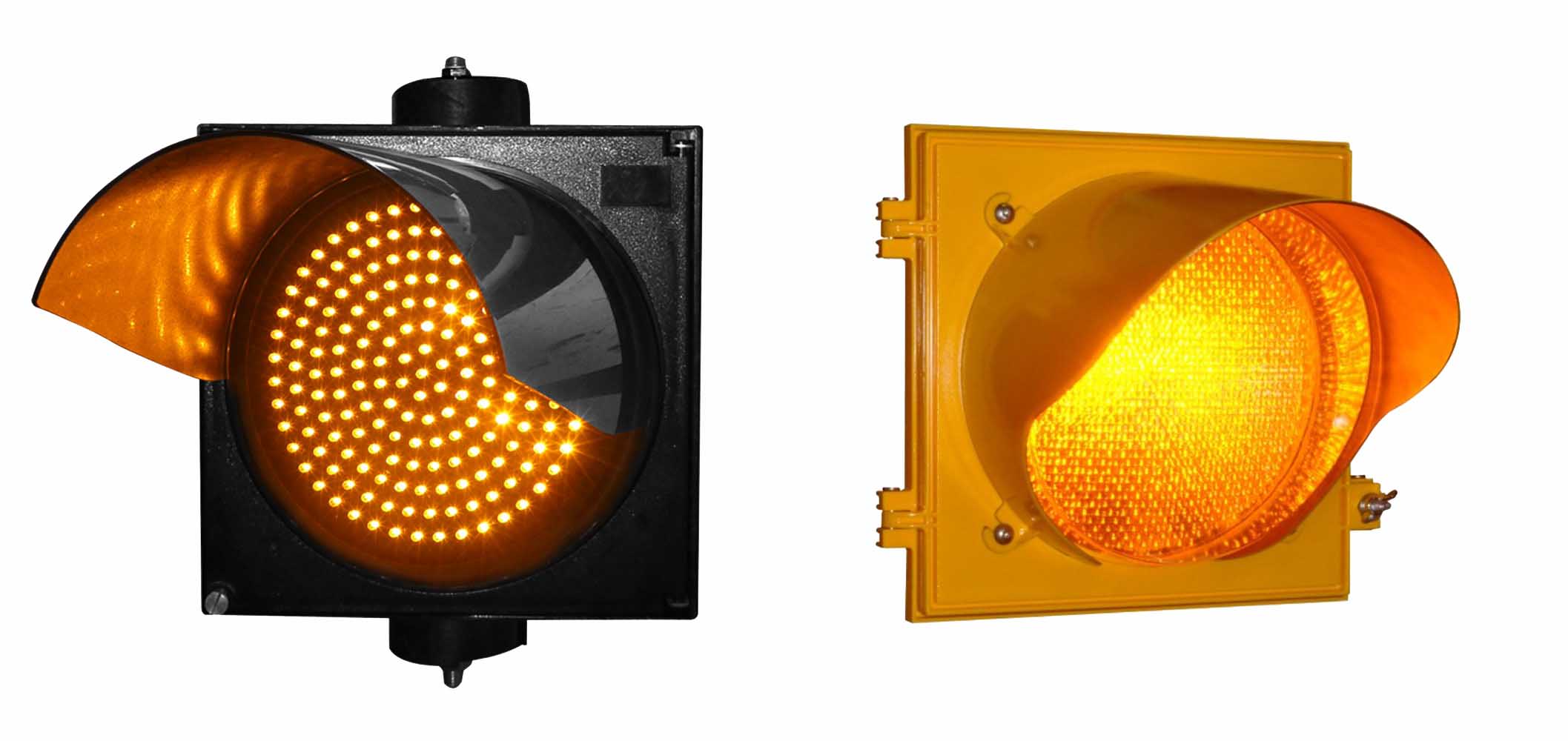
-
Special Purpose Traffic Lights
Special traffic lights are designed to satisfy unique traffic control specifications that surpass those of ordinary vehicles and pedestrians. They display red-flashing train crossing lights, flashing school zone lights that alert drivers to slow down, travel signs for buses and cable cars (which may have a T symbol or a white line), and bicycle signals with bicycle symbols. These distinctive signs enhance overall traffic safety by regulating various road users.
-
Countdown Traffic Signals
They allow people time to prepare by displaying the number of seconds left before the light changes. This entails having the ability to ascertain how long it is safe for people to cross the roadway. Drivers who use countdown timers are less likely to run red lights or stop abruptly because they are less anxious.
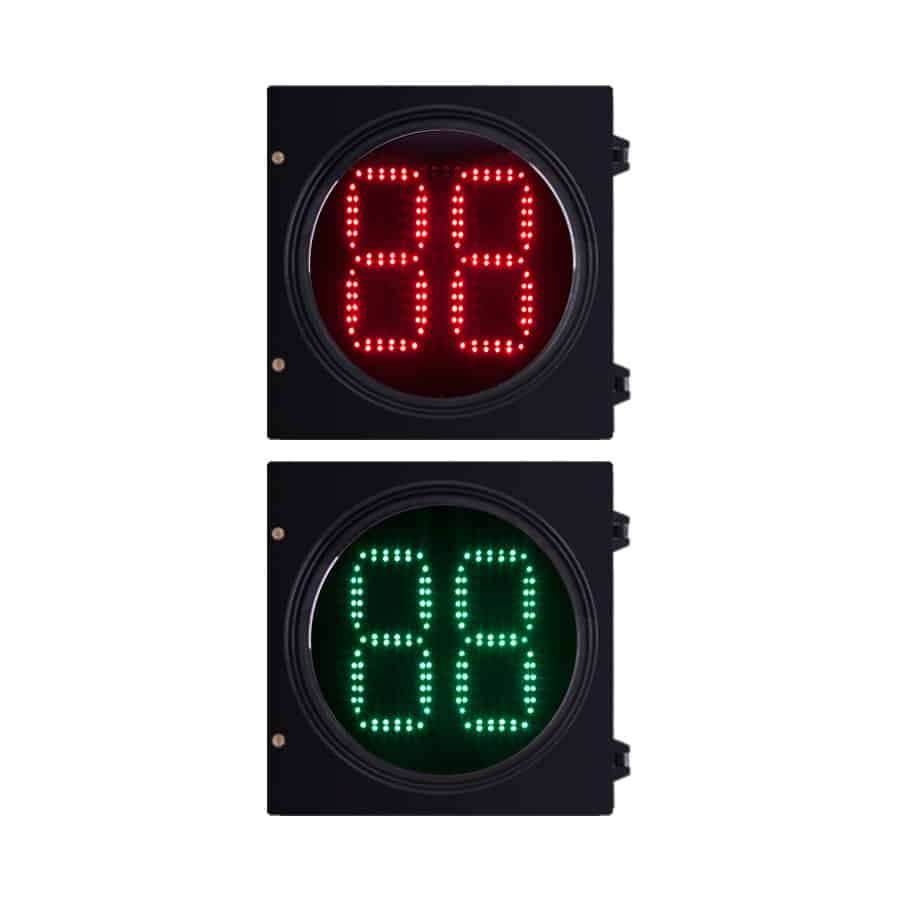
-
Temporary Traffic Signals
They are used when traditional signals are ineffective or not usable, such as on construction sites, during special events, or at accident scenes. Improved follow-through and a smoother activity flow are the results of these signals. These multipurpose lights can be turned on and off manually or with a remote control, and they are often powered by the sun or batteries. By making temporary arrangements, they guarantee that cars and pedestrians can travel safely while assisting with traffic control in crowded or shifting street circumstances.
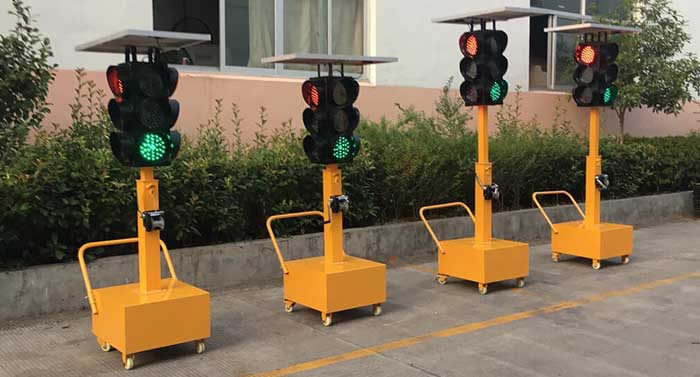
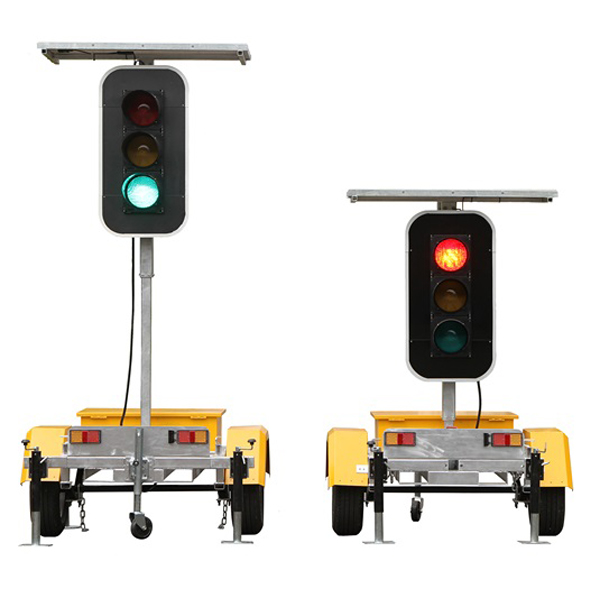
Pros & Cons of Traffic Light Types
Benefits of Different Types of Traffic Lights
Traffic signs help make traffic activities safer by preventing road crashes.
- On the roads, they could reduce the number of disgusting events like pedestrian strikes and collisions between cars at right angles.
- The ability to manage traffic at the intersection can be enhanced by signals.
- The signals aid in maintaining the safety of slower traffic by stopping heavy traffic at specified intervals.
- The signals are clearly visible at night or in cloudy conditions. So, without a signal system, traffic officers find it very challenging to manage traffic at night, in fog, or on wet days.
- Signals are a more accurate and careful way to control behavior than police officers. Under favorable circumstances, they allow for continuous travel along a specific path.
Drawbacks of Traffic Light Types
Although it is often recognized that traffic signals reduce the number of collisions at intersections, few people are aware that they might also lead to an increase in other kinds of road accidents.
- Not all traffic issues can be resolved by traffic signals alone. Optimizing traffic flow for efficiency and safety is the primary objective of every traffic engineer. Unnecessary traffic signals can cause major delays, divert drivers to unsuitable alternate routes, and encourage drivers to ignore the signals, in addition to increasing the likelihood of accidents.
- When used appropriately, activity signals are a good investment, but they cost far more than most people realize. So, how much does a traffic light cost? The cost of installing a modern traffic signal system for locals might range from $80,000 to $100,000, depending on the complexity of the intersection and the activities that take place there. Furthermore, continuous power consumption is required to keep a traffic signal running at all times. Currently, this equates to almost $1,400 annually on average.
Applications Of Different Types of Traffic Lights
-
Traffic Lights For Roadways
They can be found in intersections and crossroads and are the most prevalent type. They regulate vehicle flow and maintain order to lessen traffic and avoid collisions.
-
Traffic Lights For Parking Lots
Parking spaces in expansive commercial or open parking lots are equipped with traffic lights. It is simpler to regulate the flow of cars into and out of the area when these lights are used. To maximize parking traffic flow, they frequently use ticketing systems or sensors.
-
Urban and Suburban Road Intersections
Both urban and suburban road junctions have elements that help control traffic flow at busy crossroads in crowded regions, such as pedestrian buttons, traffic lights, real-time control systems, and assistance with left turns.
-
Traffic Lights For Tunnels & Highways
In high-traffic or busy regions, traffic lights are employed to make roads and tunnels safer. These lights regulate access, emergency stops, and road closures; they frequently work in tandem with variable message boards and speed control devices.
-
Pedestrian Crosswalks
The traffic lights at pedestrian crosswalks contribute to pedestrian safety, especially in busy urban areas, close to schools, and in the spaces between blocks. They may use sounds or clocks that display the start time.
-
School Zones
During school hours, cars are instructed to slow down in school zones by bright yellow signs or flags. In order to reflect when people enter and exit, these lights usually switch on and off at preset periods.
-
Construction and Temporary Work Zones
When roads are blocked or temporary routes are in place, engineers use lights that run on batteries to help control traffic around road construction. This protects drivers as well as workers.
-
Industrial Complexes and Private Facilities
Activity lights are used in factories, warehouses, and loading docks to regulate forklift operations, vehicle traffic, and security. Particularly in areas with both pedestrian and vehicle traffic.
Technology and Innovation in Traffic Signals
LED Technology and Energy Efficiency
The use of light-emitting diode (LED) lights is among the most noticeable advancements in traffic signals. Energy bills can be saved up to 80% when using energy-efficient lighting, which frequently uses a lot less energy than conventional light bulbs. LED displays use less energy and last for 10 years or longer. The expense of servicing and repairing is thereby decreased.
Digital and IoT Integration
Traffic systems have significantly enhanced with the combination of the Internet of Things (IoT). Central activity management systems can now broadcast and receive real-time data from intelligent activity lighting. These lights are capable of detecting emergency vehicles, adjusting their time according to local traffic flow, and even reacting to unforeseen circumstances such as power failures. Intelligent traffic lights can communicate with a city’s long-term transit system.
Smart Traffic Signals and the Future
In order to automatically improve signal timing and learn from signal patterns, these systems are configured with sensors, networks, and connectivity. They can assist emergency services, keep an eye on how well public transportation is working, and interact with cars via vehicle-to-infrastructure technologies.
Factors Influencing Traffic Light Types
- Wattage
- Efficiency
- CCT
- CRI
- Street Light Fixtures
- Adaptability
- Affordability
- Warranty
Traffic Lights Standards Worldwide
Because of international efforts to standardize road safety, there are certain similarities despite national differences in traffic light rules. The most popular method uses a widely accepted three-color code: red denotes stop, yellow (amber) denotes caution, and green denotes go. However, there are variations in terms of form, signal placement, time rules, and other aspects.
The Manual on Uniform Traffic Control Devices (MUTCD), which describes the specifications for traffic signals in the United States. Red is always on the top or left, and the signals are frequently vertical or horizontal traffic lights. Cautionary progress is made possible by flashing warning lights.
European countries presently abide by the Vienna Convention on Road Signs and Signals, which regulates pedestrian crossings, signal designs, and signal meanings. To indicate an impending switch to green, some European systems employ a red-and-yellow combination.
Despite regional differences, Asian nations like China, India, Japan, and others follow these global standards but have altered global norms in a little context. For instance, green lights are sometimes referred to as blue in Japan despite being green for linguistic and cultural reasons.
Conclusion
Types of traffic lights are the cornerstone of contemporary transportation networks, providing efficiency and safety by illuminating roadways, crossings, tunnels, and even individual offices. Due to advancements like intelligent activity management and IoT connectivity, these frameworks have developed into intelligent, flexible devices that can react to changes in real-time activity situations. From worldwide standards to innovative triggers and energy-saving techniques, traffic lights continue to have a lasting impact on portability in both urban and rural environments.
FAQs Related to Traffic Light
What are the different types of traffic light mounts?
Traffic lights can be installed in a variety of ways, like pedestrian crossings, including pedestal-mounted, span wire-mounted, overhead pole arm-mounted, and pole-mounted (horizontal or vertical).
What are the different traffic light colors?
Traffic lights come in three standard colors, and these hues are perfect for safely monitoring the movements of cars and pedestrians.
What is a traffic light?
Traffic lights are signaling devices used to control the flow of vehicles and pedestrians at intersections and crossings. They employ a consistent color system, with red denoting stop, yellow warning, and green go.
Does a computer control traffic lights?
In fact, traffic lights are controlled by central computers or traffic light controllers in most existing frameworks. At building sites or in situations when installation time is limited, simple mounts are commonly utilized.
How do traffic lights know when a car is there?
Traffic lights recognize cars using inductive loop sensors placed in the road, video traffic light cameras, or infrared or radar sensors.


-80x69.png)

